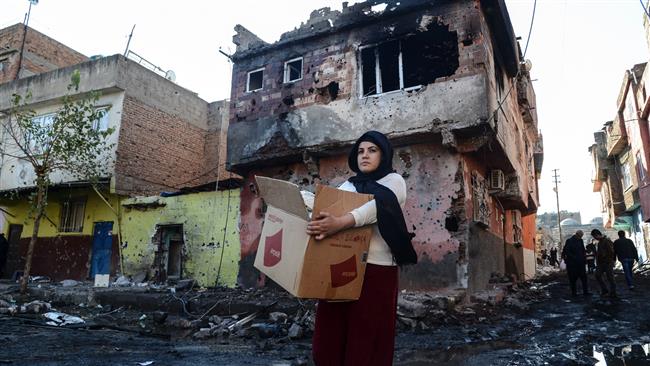Diyarbakir’s Sur District after several months of military siege
In the space of eighteen months I traveled to Turkey three times—in June 2014 on an Armenian Heritage Trip throughout the country that I wrote about for Guernica; in September 2014 to Istanbul as part of Columbia University’s Women Mobilizing Memory Workshop; and again in April 2015 to Istanbul for events commemorating the Centennial of the Armenian Genocide.
For an Armenian in the post-genocide Diaspora, several generations removed from ancestral home places and collective trauma, going to Turkey was a fraught experience, but I forged important bonds in the land where my grandparents were born. Among other inspiring and moving experiences, I visited their hometowns, and I went to Sunday services at the newly restored Sour Giragos Armenian church in Kurdish Diyarbakir’s Sur District. While in mainstream society and the media I observed denial about exactly what happened to the Armenians in 1915, as well as a disturbing current of anti-Armenian “racism” (for want of a better word), I became friends with progressive Turkish and Kurdish artists and intellectuals. We talked openly about the Armenian Genocide, and I learned more about Turkey’s complicated internal politics and history. When I left Istanbul at the end of April 2015, I fully expected that I would return in 2016 to continue the relationships and work we had begun, and even imagined that I would be in Diyarbakir to commemorate the one-hundred-and-first anniversary of the genocide.
Many of my new friends campaigned for HDP (People’s Democratic Party), a progressive, multicultural and pro-Kurdish party, in the lead-up to the June 2015 elections. When HDP crossed the required 11% threshold for entrance to the parliament—and even surpassed it by taking 13% of the vote—there was much jubilation. This was for a short time a season of hope.
When Turkish President Erdogan and his AKP party did not achieve a parliamentary super-majority that would allow them to rewrite the Turkish constitution, the government reignited its war against the Kurds in the summer of 2015 and forced another round of elections in November. It is beyond the scope of this post to discuss the many dismal events since July 2015, or the complicated internal and external politics involving the civil war in Syria, a massive refugee crisis, and the double and triple games being playing by all political actors in the region. But brutal, months-long military sieges have reduced many Kurdish neighborhoods and towns in Turkey’s southeast to rubble. Several suicide bombings have strewn dozens of bodies across the streets of Ankara, Suruc, and Istanbul. Erdogan’s renewed war on the Kurds has turned into a war against a thousand academics who signed a peace petition. Things have now devolved so far that freedom of the press, academic freedom, and freedom of speech are under threat in Turkey.
My Turkish and Kurdish academic friends who signed the peace petition are awaiting arrest and fear an imminent travel ban. And the neighborhood where Sourp Giragos is situated—where I had hoped to be on 24 April 2016—has become a bombed-out war zone.
In this dire situation, I look back on last year’s hopeful connections and realize that now, more than ever, the work of commemorating and recognizing the Armenian Genocide of 100 years ago is and must be intimately bound up with the ongoing struggle for justice for the Kurds and the fight for civil and human rights for all who live in Turkey.
UPDATE: The day after I wrote this, there was a deadly bombing attack on Istanbul’s popular Istiklal Avenue pedestrian shopping district. This is the same street on which we gathered with thousands of people in front of the French Consulate on 24 April 2015 for a solemn commemoration of the Centennial of the Armenian Genocide. (19 March 2016)
Nancy Kricorian
New York, NY
March 18, 2016
